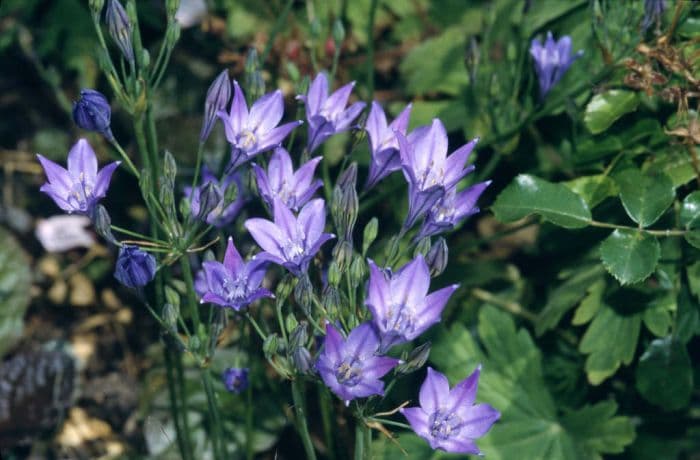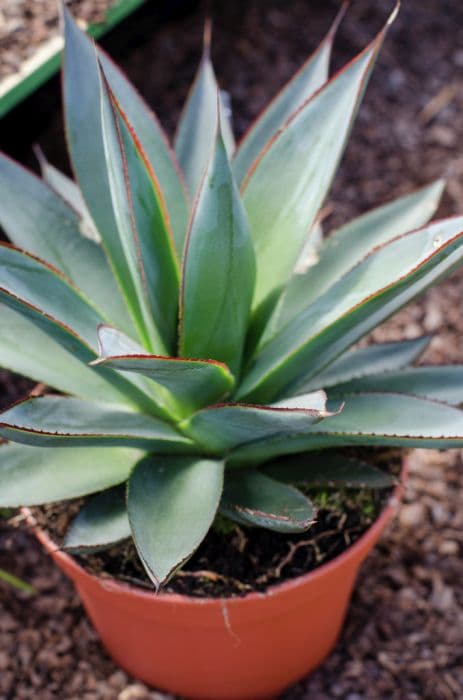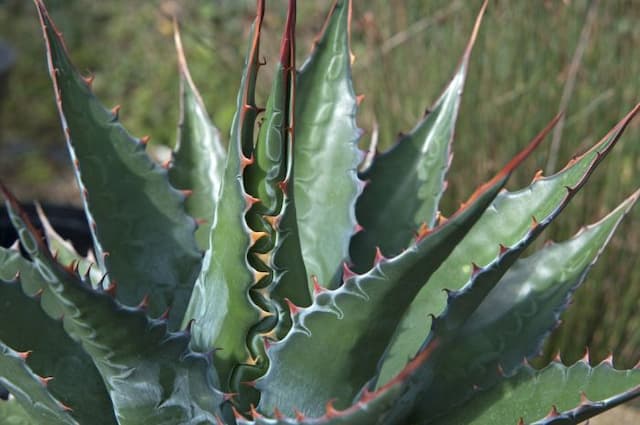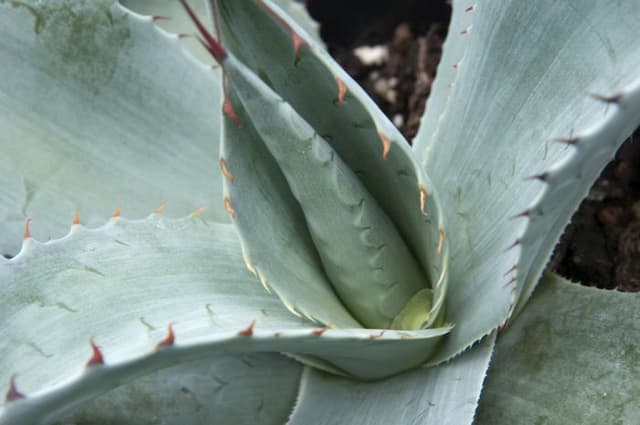Ithuriel's Spear Triteleia laxa

ABOUT
The plant known as Ithuriel's spear showcases a captivating display of funnel-shaped flowers that are often arranged in loose clusters or umbels. These striking blooms typically bear a vivid blue or sometimes a violet hue, occasionally with hints of white or light pink. The petals exhibit a delicate texture, curving gently outwards, creating an inviting appearance. These blossoms exude a sense of grace, each one borne on slender, leafless stalks that rise above the greenery beneath. The foliage of Ithuriel's spear consists of long, narrow leaves that are typically a rich green, creating a lovely contrast against the soil from whence they grow. The leaves may also produce a linear progression along the stems, adding to the plant's overall slender and elegant structure. This plant's allure is enhanced during its blooming period, when the vivid colors and elegant structure come together to create a stunning visual display in gardens and wild landscapes alike.
About this plant
 Names
NamesFamily
Asparagaceae.
Synonyms
Ithuriel's Spear, Grassnut, Triplet Lily, Wally Basket.
Common names
Brodiaea laxa, Calliprora laxa, Hesperoscordum laxum, Themis laxa.
 Characteristics
CharacteristicsLife cycle
Perennials
Foliage type
Deciduous
Color of leaves
Green
Flower color
Blue
Height
1-2 feet (0.3-0.6 meters)
Spread
0.5-1 feet (0.15-0.3 meters)
Plant type
Bulb
Hardiness zones
5
Native area
California
Benefits
 General Benefits
General Benefits- Low Maintenance: Triteleia laxa, commonly known as Ithuriel's Spear, requires minimal care once established, making it suitable for gardeners looking for low maintenance options.
- Drought Tolerance: It is drought-tolerant, which means it can survive with little water and is ideal for xeriscaping or dry climate gardens.
- Attracts Pollinators: The vibrant flowers of Ithuriel's Spear attract bees, butterflies, and other beneficial pollinators, promoting biodiversity in the garden.
- Ornamental Value: With its striking blue to purple flowers, Ithuriel's Spear adds aesthetic value and a splash of color to any landscape.
- Good Cut Flowers: The blooms make excellent cut flowers, with long-lasting vase life, perfect for floral arrangements.
- Naturalizing: Ithuriel's Spear has the ability to naturalize by seed, creating larger displays of blooms over the years without much intervention.
- Resistant to Pests: It is generally resistant to pests and diseases, thus reducing the need for chemical treatments in the garden.
- Easy Propagation: Ithuriel's Spear can be easily propagated by dividing corms, making it simple to expand your garden or share with friends.
- Versatile Planting Options: This plant is suitable for planting in a variety of settings such as borders, beds, and containers, providing flexibility in garden design.
- Late Spring to Early Summer Blooming: Its blooming period in late spring to early summer helps to bridge the gap between early spring bulbs and summer perennials.
 Medical Properties
Medical PropertiesThis plant is not used for medical purposes.
 Air-purifying Qualities
Air-purifying QualitiesThis plant is not specifically known for air purifying qualities.
 Other Uses
Other Uses- Triteleia laxa, commonly known as Ithuriel's spear, can be used as a dye plant. The bulbs can produce colors for textiles, though this isn't a widely practiced technique.
- Ithuriel's spear's stems and flowers can be used in the art of flower arranging due to their striking blue to purple flowers and long-lasting qualities.
- The corms (bulb-like structures) of Ithuriel's spear are sometimes used in crafting and jewelry-making as beads once they are dried and drilled with holes.
- When integrated into garden designs, Ithuriel's spear is excellent for creating contrasting texture and color, especially in rock gardens or as a border plant.
- Gardeners also use Ithuriel's spear for xeriscaping—a landscaping approach that reduces the need for irrigation—as they are drought-resistant once established.
- The plant can be used in educational settings as a part of botany studies to teach about native Californian flora and bulb propagation.
- In photography, its vibrant blooms provide a natural point of interest and are used to add visual appeal in wildlife and botanical photo shoots.
- Ithuriel's spear can serve a role in ecological education and conservation practices by being an example of a plant beneficial to pollinators.
- The plant has been used in large public landscaping projects to add seasonal interest since it provides a burst of color when in bloom, typically in late spring to early summer.
- As a subject in art and illustration, Ithuriel's spear inspires artists with its intricate flower structure and vibrant colors, from botanical illustrations to modern plant-inspired designs.
Interesting Facts
 Feng Shui
Feng ShuiThe Ithuriel's spear is not used in Feng Shui practice.
 Zodiac Sign Compitability
Zodiac Sign CompitabilityThe Ithuriel's spear is not used in astrology practice.
 Plant Symbolism
Plant Symbolism- Grace and Beauty: Triteleia laxa, commonly known as Ithuriel's spear, showcases delicate, funnel-shaped blooms, which have come to symbolize grace and beauty comparable to that of a mythical or angelic entity.
- Spiritual Enlightenment: The pointed nature of the flower stems and the name "Ithuriel's spear" suggest a connection to the divine, embodying the quest for truth and enlightenment.
- Resilience: Ithuriel's spear is known to thrive in various conditions, symbolizing the ability to persist and adapt through life's challenges.
- Revelation of Truth: Legend has it that the angel Ithuriel could reveal deceit with his spear; therefore, the plant can represent an unveiling or revelation of truth.
 Water
WaterThe Ithuriel's spear, commonly known as Triteleia laxa, should be watered deeply roughly once a week, providing about one to two inches of water each time. It is important to allow the soil to dry out between waterings to prevent rot. During the active growing season in the spring and early summer, depending on the weather, you may need to water twice a week, especially in dryer conditions. Reduce watering frequency once the plant has finished blooming and is entering dormancy, generally after the summer, to prevent excess moisture that can damage the bulb.
 Light
LightIthuriel's spear thrives in full sun to partial shade. It performs best when it receives at least six hours of direct sunlight daily. Plant it in a location where it can enjoy morning sun, which is gentler, and possibly dappled shade in the afternoon to protect it from the intense heat of late day sun, often favored in Mediterranean climates.
 Temperature
TemperatureIthuriel's spear prefers moderate climate conditions and fares best within a temperature range of 40 to 85 degrees Fahrenheit. It can withstand brief periods of colder temperatures down to around 20 degrees Fahrenheit. However, prolonged exposure to temperatures outside the 40-85 degrees Fahrenheit range can be harmful to the plant.
 Pruning
PruningIthuriel's spear typically requires minimal pruning. After blooming, the flower stalks can be cut back to the base, but it's important to leave the foliage in place until it dies back naturally to allow energy to return to the bulb. Pruning is usually done once a year, in the late summer or early fall, after the plant has finished its lifecycle for the season.
 Cleaning
CleaningAs needed
 Soil
SoilThe Ithuriel's spear (Triteleia laxa) thrives best in a well-draining soil mix, with a preferred pH range of 6.0 to 8.0. A mixture of loam, sand, and peat ensures good drainage and aeration. Amending with organic matter like compost can enhance soil fertility.
 Repotting
RepottingIthuriel's spear generally requires repotting every 2-3 years to refresh the soil and accommodate growth. Maintenance of bulbous plants includes dividing the clumps during repotting if they become overcrowded.
 Humidity & Misting
Humidity & MistingIthuriel's spear prefers moderate humidity levels but is relatively adaptable to different humidity conditions as long as it is not extremely high or low, ensuring good air circulation to avoid fungal issues.
 Suitable locations
Suitable locationsIndoor
Provide bright indirect light and well-draining soil for Ithuriel's spear.
Outdoor
Plant in well-draining soil, full sun to partial shade for Ithuriel's spear.
Hardiness zone
5-9 USDA
 Life cycle
Life cycleTriteleia laxa, commonly known as the Ithuriel's spear, begins its life cycle when its bulb-like corm is planted in the ground and typically enters a period of dormancy during dry summer months. After the winter rains, the corm awakens in spring, sending up grass-like leaves and a flower stalk that bears clusters of star-shaped blue to purple flowers. Following pollination, often facilitated by bees, the flowers develop into capsules filled with seeds. As the growing season ends, the above-ground foliage dies back, and the plant returns to dormancy, relying on the corm to store energy for the next cycle. Seeds that fall to the ground have the potential to grow into new corms, slowly enlarging the colony of plants. The cycle repeats annually, with corms being able to produce flowers for several years.
 Propogation
PropogationPropogation time
Spring to Summer
The most popular method for propagating Triteleia laxa, commonly known as Ithuriel's spear, is through its corms. Corms are underground storage organs that contain nutrients for the plant's dormant season. Propagation via corms is typically done in the fall after the foliage has died back, signaling that the corms have entered dormancy. Gardeners dig up the corms, gently separate them, and replant them about 3 inches deep (approximately 7.6 cm) and 3 to 6 inches apart (7.6 to 15.2 cm). This allows each corm enough space to develop properly. Given the right conditions, these corms will produce shoots in the following spring, eventually leading to the growth of new Ithuriel's spear plants. This method is favored for its simplicity and the high success rate of the resulting new plants.









